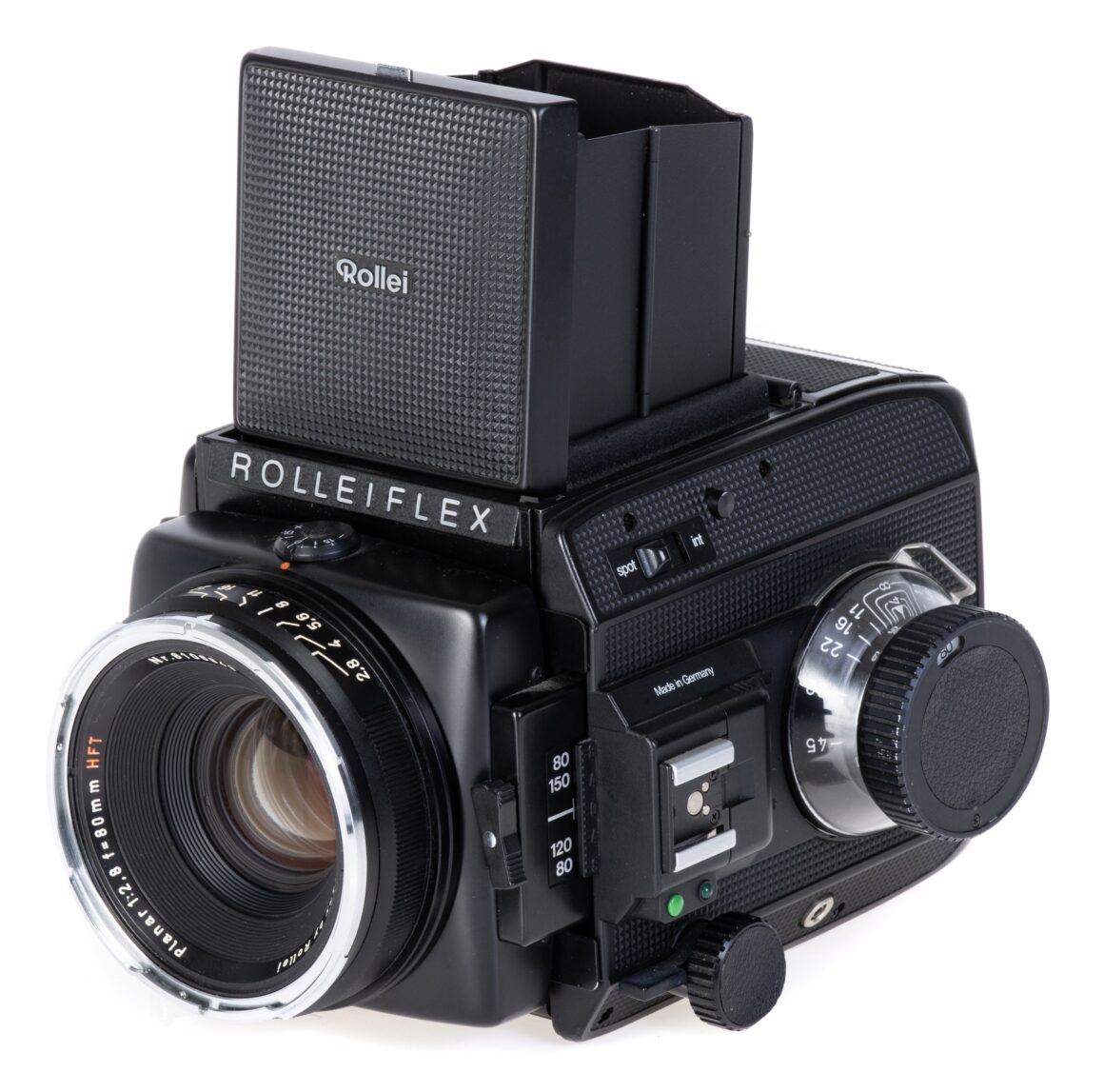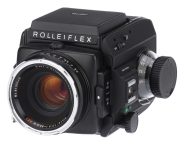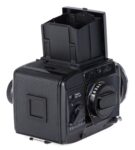Rolleiflex SL66SE
Medium format MF film SLR camera
Specification
| Production details: | |
| Announced: | April 1986 |
| System: | ● Rolleiflex SL66 (1966) |
| Format: | |
| Maximum format: | Medium format 6x6 |
| Film type: | 120 roll film |
| 220 roll film | |
| Mount and Flange focal distance: | Rolleiflex SL66 [102.8mm] |
| Shutter: | |
| Type: | Focal-plane |
| Model: | Mechanical |
| Speeds: | 1 - 1/1000 + B |
| Exposure: | |
| Exposure metering: | Through-the-lens (TTL), open-aperture |
| Exposure modes: | Manual |
| Physical characteristics: | |
| Weight: | 1590g |
| Dimensions: | 118x150x148mm |
Manufacturer description #1
Rolleiflex SL 66 SE and Rolleiflex SL66X - The State of the Art in Medium Format
Outstanding results can be achieved more easily and reliably with the advanced technology of a professional camera system.
These cameras incorporate the very latest developments in photographic technology but are easy and straightforward to operate. Now that the Rolleiflex SL 66 SE and the Rolleiflex SL 66 X are on the market, very few technical obstacles stand between the photographer and the realization of his creative ideas. The main features of these systems are:
- Mechanical SLR cameras for 6 x 6 (2 1/4 x 2 1/ 4) and 4.5 x 6 (1 5/8 x 2 1/4) format
- Built-in bellows for close-up photography without accessories
- Lens mounting with ± 8° tilt for application of the Scheimpflug principle (extended depth of field)
- TTL exposure metering. Can be switched from spot to integral metering (on the Rolleiflex SL66SE)
- TTL automatic flash control with flash metering at the film surface
- Focal plane shutter, 1 to 1/ 1000 sec and B
- Professional film magazine for 6 x 6 (2 1/4 x 2 1/4) or 4.5 x 6 (1 5/8 x 2 1/4) format or Polaroid stock
- Top-performance Zeiss lenses from 30 to 1000 mm.
Both these cameras are distinguished by their great versatility, which is why they are so popular with serious photographers in many different fields of photography.
The Basis of a Perfect System
The photogropher can now rely on professional-quality mechanics without giving up the precision and speed offered by modern methods of exposure metering. The Rolleiflex SL66SE has built-in exposure metering which can be switched from integral to spot readings. In this sense, it is a "universal" camera, i.e. it can be used in the studio or outdoors, in constant or changing light conditions. Even when the battery is low, all the camera features apart from exposure metering remain fully operational.
The Rolleiflex SL66X is the ideal camera for assignments carried out mainly in constant light conditions, e. g. studio photography. Aperture and shutter speed are balanced using external metering. With this camera, even difficult shots, i.e. in the close-up or macro range, can be taken without major problems. This model also incorporates the modern TTL automatic flash system, which monitors and controls the flash light at the film.
The Whole Spectrum of Professional Photography
The wide range of applications of the Rolleiflex SL 66 SE and the Rolleiflex SL 66 X is more than ample proof that these models represent the most advanced examples of pioneering photographic technology. This camera system successfully combines robust, reliable mechanics with fast-acting electronics that virtually make wear and tear a thing of the past. The system incorporates built-in bellows with a tilting lens holder, automatic flash with TTL flash exposure metering off the film, a range of lenses that leaves nothing to be desired - and much more. Every part of these cameras is built to the highest standards of precision. The truth is that these models are the envy of camera manufacturers all over the world! In terms of improved picture quality, they open up almost unlimited possibilities in every branch of classical photography.
Built-in TTL Exposure Metering - Spot or Integral Metering at the Flick of a Switch For the Last Word in Picture Quality
The Rolleiflex SL 66 SE has the most reliable exposure metering system available on the market today; through-the-Iens metering built into the camera body. LED indicators in the viewfinder show red for over- or under-exposure, yellow when the exposure deviates by half a stop, or green for the correct exposure. Exposure can be balanced with aperture or shutter priority. This method of exposure control simplifies and speeds up the photographer's work and ensures reliable measurements. The built-in exposure electronics provide problem-free camera operation, even with difficult shots or subjects. Angle of view and extension factors are automatically taken into account by the meter and remain fully operational with all the finder systems.
But the Rolleiflex SL 66 SE offers even more than this! The measurement characteristics can be set to either spot or weighted integral metering (simultaneous-multi-spot-measurement). With integral metering, the centre-weighted silicon cell is connected up with four other photocells aimed at various points in the image field. This extensive metering not only provides a higher weighting in the lower half of the image, but also substantially compensates for any stray light entering through the viewfinder. This dual metering system makes the camera ideal for any photographic situation. It offers integral metering for relatively evenly lit large-area subjects and spot metering for back-lit shots and subjects with high contrast.
Through-the-Lens Flash Metering: for Reliable Results in the Studio or Outdoors
The flash metering system in the Rolleiflex SL66SE and SL66X incorporates the very latest photographic technology. When used in conjunction with automatic flash units and a special adapter on the SCA 300 system (e.g. Rollei SCA 356), a sensor monitors the light falling on the film through the lens during the exposure. It then meters out the flash energy required for the particular subject. This process automatically takes account of extension factors for filters, extension tubes or bellows - an invaluable asset, particularly in the close-up and macro range. And experienced photographers know that this is where exposure control is the most difficult, so the Rollei SL 66 accessory range includes a special macro flash.
Automatic flash can also be used with professional studio flash equipment, in conjunction with the FMI TTL flash exposure meter. The quantity of light can be regulated by adjusting the camera aperture or the light output of the flash equipment. For the trial flash required to balance the exposure, metering camera backs are available with spot or integral readings.
Unique Feature: the Built-in Tilting Bellows with Three Different Applications
The Rolleiflex SL66SE and SL66X have a built-in bellows for distance adjustment, which can also be tilted up to ± 8° in the vertical plane. This device offers the photographer additional advantages and creative opportunities:
1. Extended depth of field by tilting the bellows (the so-called Scheimpflug* effect)
2. Access to close-up and macro photography without accessories, especially when using a reverse- mounted lens
3. Shorter distance from the subject, even with long-focus lenses (e. g. 60 cm with 150 mm focal length)
Photos Sharp Right to the Edge: No Other Camera Can Offer This Kind of Quality!
By tilting the bellows ± 8° relative to the film plane, the depth of field can be significantly increased without altering the aperture. This is an advantage when poor light conditions require a wide aperture.
Or when the edges of the subject extend further than the depth of field available with the smallest aperture. The Scheimpflug* principle provides the answer to the problems of photographing subjects with vertical surfaces, e.g. in architectural photography (fronts of buildings, facades, walls, frescos, painted ceilings, etc!. And it has its advantages in table-top photography too. Less flat subjects can be brought into sharp focus by stopping down. This procedure is particularly useful when employed in conjunction with the PCS-Rolleigon shift lens.
* Named after the man who discovered it, the geodetic surveyor Theodore Scheimpflug. This principle states that if the planes of the film, lens and subject can be made to converge, the resulting image will be sharp overall.
Close-up and Macro Photography with Reverse-mounted Lenses
With the bellows, close-up and macro photography are possible without any other accessories. In particular, the image scale can be significantly increased without any need for extra equipment by simply mounting the lens back to front. For example, over 3:1 can be achieved with a 50 mm wide-angle lens. The lenses that can be reverse-mounted on the SL 66 SE and SL66X are the f4/50 mm, f3.5/60 mm, f2.8/80 mm and f5.6/120 mm lenses. With the aid of the scales on the bellows extension, the camera can be set directly to the required magnification for each focal length. For superior reproduction, the image scale should be greater than 1:1.
Shorter Subject Distance - even with Longer Focal Lengths
The full extension of the bellows is 50 mm. With the standard f2.8/80 mm lens, a bellows movement of 7.5 mm covers the range 1 m to infinity. The remaining 42.5 mm extension is available for close-up photography. The scales on the slide rail also show, next to the magnification factors, the exposure value corrections for three lenses (80, 120, 150 mm). (This is only significant for the Rolleiflex SL 66 X, since the SL66SE has automatic exposure metering). A millimetre scale is a further aid to precision.
The Rolleiflex Interchangeable Magazine System: the Right Film for Every Situation
Photographers know the situation only too well: a new subject or a fundamentally different interpretation calls for a change of film stock. Or you want to slip in a Polaroid shot to check the lighting. With this in mind, the Rolleiflex SL 66 SE and SL 66 X incorporate a professional interchangeable magazine system. Magazines for 6x6/120, 6x6/220, 4.5x6/120 and 4.5x6/220 films were designed in close cooperation with well-known photographers. These magazines can be changed in an instant without losing a single frame. The small, handy crank for leading in and winding up the film, the film speed input facility (for exposure metering), the interchangeable film inserts and the slot for storing the darkslide are just a few of the useful features on these magazines.
In addition, the accessory range includes a cassette adapter for use with sheet film cassettes and a Polaroid magazine for 8.3 x 10.8 cm (3 1/4 X 4 1/4 in) Polaroid pack film-types 107, 108, 667, 668, 669 and 665. The Polaroid magazine gives you the choice, for each frame, of exposing two photographs in the 4.5x6 format or a single shot in the 6x6 format. The use of a single frame for two 4.5x6 exposures has obvious advantages for the cost-conscious professional: two lighting or exposure alternatives can be compared on a single Polaroid print.
Peak Lens Performance
The key advantages of a professional camera design are quality and versatility. Here, the lenses available for the camera system are vital. Even the best camera is only as efficient and versatile as its interchangeable lenses. A complete range of lenses was designed for the Rolleiflex SL66SE and Rolleiflex SL66X in close collaboration with Carl Zeiss. The outstanding performance of these lenses has earned them a world-wide reputation for being "Made in Germany."
Special Tasks Need Special Solutions: Rollei Has Them
Photography is a fascinating pursuit for people from all walks of life. The tasks and requirements of photographers are just as varied. Rollei offer top-performance professional equipment for unusual and "way-out" applications as well as standard photographic assignments. This is evident from their elaborately developed technology and their range of lenses for special applications.
For instance, the PCS-Rolleigon shift lens with a ball/tilt adapter is an ideal addition to the SL 66 SE and SL 66 X. It opens up the wide field of still life photography and for many jobs makes these models real alternatives to the view camera.
The Luminar magnifying lenses serve a completely different purpose. They give access to subjects that are invisible to the human eye and show fascinating and even disturbing aspects of the microscopic world. Thus, whether it's for architectural photography or macro work, the preparation of photographic records or creative portrait photography, Rollei's advanced camera technology and lens designs have the answer.
Manufacturer description #2
TYPE: A 6 x 6 SLR automatic camera with TTL exposure meter, built-in bellows and interchangeable film magazine. Lens holder with bellows, lens vertically tiltable by +/-8° for extended depth. Mirror pre-release and multiple exposure switch. Equipped for automatic flash units with through-the-lens exposure metering.
INTERCHANGEABLE MAGAZINES: Magazines for 6 x 6/120 film, 6 x 6/220 film, 4.5 x 6/120 film and 4.5 x 6/220 film. They are equipped with magazine drawslide, magazine winder knob, holder for tear-off tab from the film box and storage compartment for the magazine drawslide. Film wind-up with automatic stop at frame 1. Film speed setting for the exposure meter on the right side of the magazine. ASA 25-6400 (15-39 DIN). Film counter for 1-12, switchable to 1-24, returns to zero when the film is changed. Magazine 4.5 x 6 horizontal format with counter 1-16, switchable to 1-32. Rollei Polaroid magazine 6 x 6 or two times 4.5 x 6 for Polaroid film packs. The Rollei magazine can be interchanged irrespective of the number of pictures taken.
STANDARD LENS: Planar f 2.8/80 mm, angle of view 52°. Distance range in normal mounting INFINITY to 16 cm, in reverse mounting 16 cm to 12 cm.
INTERCHANGEABLE LENSES: Zeiss lenses with focal lengths of 30-1000 mm, some mountable in the reverse position.
SHUTTER: Focal plane shutter, speed range 1 s - 1/1000 s and B, X-contact, X-synchronization 1/30 s.
VIEWFINDER: Mirror-reflex viewfinder, damped mirror movement with partially transparent multicoating, clear focusing screen with microprism area and split-image wedge (interchangeable). Folding viewing head with magnifier lens (3x), interchangeable with rigid magnifying head or prism head.
EXPOSURE METERING SYSTEM: Spot measurement through integral metering by means of 5 spectral-corrected silicon photo-elements behind the swinging mirror. The measuring range for ASA 100/21 DIN spans exposure values 1-18, measured with the standard Planar f 2.8/80 mm lens. The exposure meter is activated by lightly pressing the shutter release. Switchover from the spot to integral metering mode is done via the select switch. Stray light compensation. Metering angle for spot measurement is <3° with f:80 mm. The film speed is adjusted on the magazine, in the range 25-6400 ASA (15-39 DIN). The measured exposure is balanced by means of 5 different-coloured LED indicators in the viewfinder. Exposure correction switch for -1.5 to +1.5 EV steps.
BATTERY: 6 V silver oxide or lithium (PX 28).
FLASH EXPOSURE METERING: Through-the-lens flash metering by the use of a fully automatic flash unit with Rollei SCA 356 adapter. A sensor measures the light reflected from the film surface and an electronic control system in the Rollei flash adapter measures out the necessary flash energy. Mounting and electrical contact for the system adapter or the Rollei FM 1 take place via the hot shoe on the left side on the camera.
FOCUSING: By means of built-in bellows, 50 mm extension. Focusing knob at the side with distance scales built in for 50, 80, 150 and 250 mm focal lengths.
EXTENDED DEPTH: (According to the Scheimpflug principle). The lens holder can be tilted 8° upwards or downwards; it is self-locking in the middle and two end positions.
FILM TRANSPORT: By means of a transport crank, coupled to the shutter cocking mechanism. The multiple exposure locking device can be disengaged.
From the editor
Manufactured 04/1986 – 10/1992 in Germany, 3.500 units.
Special limited editions (1)
- Rolleiflex SL66SE "Exclusive Professional" (188 units) - 1992



